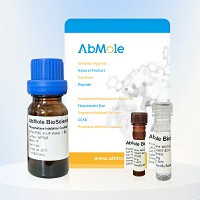All AbMole products are for research use only, cannot be used for human consumption.

Hyaluronidase (Hyaluronate 4-glycanohydrolase; Hyaluronoglucosaminidase) is a naturally occurring enzyme that depolymerizes hyaluronic acid by cleavage of glycosidic bonds. Hyaluronidase can be used to temporarily reduce the viscosity of the intercellular substance and promote the subcutaneous Infusion, locally accumulated exudate or blood accelerates diffusion and facilitates absorption. In addition, Hyaluronidase can be used to construct animal models of retinal detachment.
| CAS Number | 37326-33-3 |
| Solubility (25°C) | Water 100 mg/mL |
| Storage | -20°C, protect from light, dry, sealed |
| Related Animal Modeling Products |
|---|
| 3,4-Benzopyrene
3,4-Benzopyrene shows lung carcinogenicity in animal models. |
| Sodium Thioglycolate
Sodium thioglycolate acts as reducing agent and is suitable for anaerobic and microaerophilic bacterial growth. Sodium thioglycolate is a commonly used reagent for bacteriological research to maintain reducing conditions in media. Thioglycolate can also protect enzymes against inactivation by maintaining protein thiol groups in the reduced state. Thioglycolate medium is frequently used in inflammation research to elicit a neutrophil and macrophage response in vivo. |
| Vancomycin-d10 2TFA salt
Vancomycin-d10 2TFA salt |
| Acetic acid-d4
Acetic acid-d4 |
| Myosin H Chain Fragment, mouse acetate
Myosin H Chain Fragment, mouse acetate salt is a fragment of the α-Myosin heavy chain peptide. Myosin H Chain Fragment can be used to induce experimental autoimmune myocarditis (EAM) mouse model. |
All AbMole products are for research use only, cannot be used for human consumption or veterinary use. We do not provide products or services to individuals. Please comply with the intended use and do not use AbMole products for any other purpose.


Products are for research use only. Not for human use. We do not sell to patients.
© Copyright 2010-2024 AbMole BioScience. All Rights Reserved.
